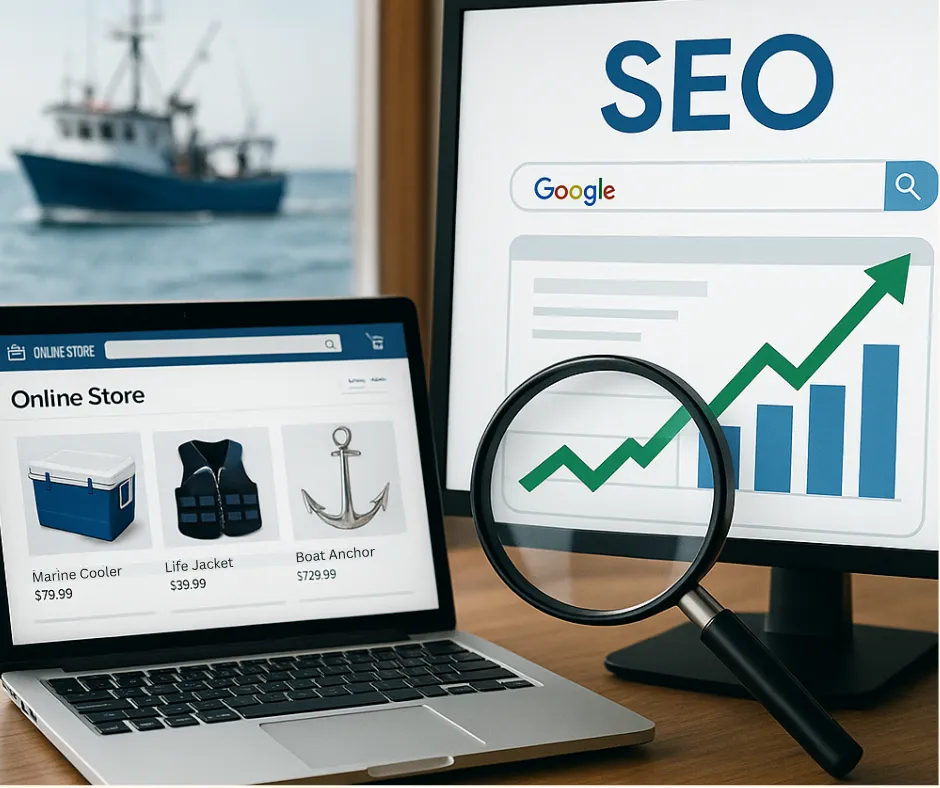How Marine DTC Stores Can Get Found Online and Grow with Smarter SEO


If you run an online store that sells marine products—whether it’s boat parts, gear, or accessories—you probably already know how competitive the space is. But what many marine business owners don’t realize is that search engine visibility is one of the biggest drivers of traffic and sales.
This guide will walk you through how to get more buyers to your website by using smarter marine eCommerce SEO strategies—including how to assess your site, improve its performance, and stand out from competitors. We’ll also explain technical terms in plain language so you can take confident steps, even if you’re not an SEO expert.
Why SEO Matters for Marine DTC Stores
If people can’t find your products on Google, they can’t buy them.
Marine DTC (Direct-to-Consumer) brands sell directly through their websites, often without a physical storefront. That means your visibility online is everything.
Here’s why marine DTC eCommerce SEO is so important
- High-intent buyers use Google to search for marine parts, electronics, and gear.
- Organic traffic (unpaid clicks from search engines) is sustainable and cost-effective.
- SEO helps reduce your dependence on paid ads and social media.
And yet, many marine eCommerce websites aren’t optimized properly. That’s where simple SEO strategies—like fixing product page issues or improving loading times—can make a big difference.
Smart SEO Strategies for Your Marine DTC Online Store
Step 1: Evaluate Your Website with an SEO Checkup
The first step to improving your visibility is running a marine eCommerce website audit. Think of it like a tune-up for your online store.
Here’s what to look for:
- Are your product pages showing up in Google search?
- Do you have duplicate or outdated pages?
- Are your images slowing your site down?
- Are your page titles and descriptions clear and keyword-friendly?
You can do some of this manually or work with a specialist who knows how to audit marine DTC websites. At Digital Deckhand, our SEO services include a detailed site checkup tailored for marine stores—from boats and motors to marine lifestyle gear.
Step 2: Make Your Website Easy for Google and (Shoppers) to Understand
This is where marine eCommerce technical SEO comes in. That just means making sure your website is set up in a way that search engines can crawl and understand.
Here’s how to do that in simple terms:
- Use clear, simple URLs like /products/boat-anchor instead of /?id=48372
- Add keywords (like “marine GPS” or “fishing rod holder”) to product names and page titles
- Make sure there are no broken links or empty product pages
- Link your product pages from your main category pages so people and search engines can find them easily
If this sounds overwhelming, don’t worry—tools like Google Search Console can help you spot issues, or you can consult SEO pros who specialize in marine websites.
Related Reading: How to Write Product Descriptions That Convert
Step 3: Speed Up Your Site for More Sales
Would you wait 5 seconds for a page to load while you’re on your boat trying to buy a part?
Neither would your customers.
eCommerce site speed optimization is a fancy term that means “make your website load fast.” A slow website can kill your sales and hurt your search rankings.
Here are ways to improve speed without rebuilding your site:
- Compress large images (especially for product photos)
- Avoid using too many pop-ups or tracking scripts
- Use modern image formats like WebP
- Work with a developer to set up lazy loading for images and product reviews
Even small changes can reduce your bounce rate (when people leave your site right away) and boost your SEO.
Step 4: Offer a Great Experience, Build Trust, and Stand Out
A. Help Customers Find the Right Products Faster
- Use smart product recommendations (“You may also need this mount for your trolling motor”)
- Add a chatbot or support form for fitment or compatibility questions
- Organize products by use case (e.g., “Saltwater Fishing Gear” or “Docking Essentials”)
B. Highlight Your Sustainability Practices
Many buyers today care about eco-friendly brands. Let them know if you:- Use biodegradable packaging
- Partner with marine conservation groups
- Offset shipping emissions
C. Embrace Innovation to Stay Ahead
Think beyond just selling parts. You can:- Add marine lifestyle products (apparel, accessories, books)
- Offer subscription bundles for maintenance kits
- Create how-to guides and videos to answer common questions
This kind of content doesn’t just help with SEO—it builds brand loyalty and encourages repeat visits.
Take the Next Step: Get Expert Help with Marine SEO
You don’t need to become an SEO expert overnight. But you do need a website that loads fast, shows up in Google, and helps customers find what they’re looking for.
Here’s how Digital Deckhand can help:
✅ Run a full SEO checkup for your site
✅ Fix speed, structure, and content issues
✅ Create a plan to attract more marine buyers and convert better
Grow Your Marine ECommerce Store Now!
If you want to grow your marine eCommerce store, SEO is your foundation. It’s how people find you, how they trust you, and how you scale your business long-term—without constantly paying for ads.
Start with small improvements: clean up your site, speed it up, and offer real value to your customers. With a smart SEO strategy in place, your marine DTC store won’t just stay afloat—it’ll thrive.
Frequently Asked Questions (FAQs)
- Your site hasn’t been indexed properly
- You lack optimized page titles, descriptions, or product content
- You have technical issues like slow load times or broken links
- You don’t have enough relevant content or backlinks
